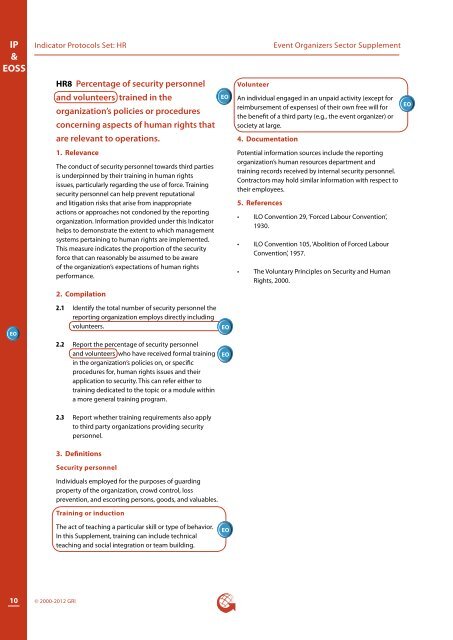Event Organizers Sector Supplement - Global Reporting Initiative
Event Organizers Sector Supplement - Global Reporting Initiative
Event Organizers Sector Supplement - Global Reporting Initiative
Create successful ePaper yourself
Turn your PDF publications into a flip-book with our unique Google optimized e-Paper software.
IP<br />
&<br />
EOSS<br />
Indicator Protocols Set: HR<br />
<strong>Event</strong> <strong>Organizers</strong> <strong>Sector</strong> <strong>Supplement</strong><br />
HR8 Percentage of security personnel<br />
Volunteer<br />
and volunteers trained in the<br />
organization’s policies or procedures<br />
concerning aspects of human rights that<br />
are relevant to operations.<br />
EO<br />
An individual engaged in an unpaid activity (except for<br />
reimbursement of expenses) of their own free will for<br />
the benefit of a third party (e.g., the event organizer) or<br />
society at large.<br />
EO<br />
4. Documentation<br />
1. Relevance<br />
The conduct of security personnel towards third parties<br />
is underpinned by their training in human rights<br />
issues, particularly regarding the use of force. Training<br />
security personnel can help prevent reputational<br />
and litigation risks that arise from inappropriate<br />
actions or approaches not condoned by the reporting<br />
organization. Information provided under this Indicator<br />
helps to demonstrate the extent to which management<br />
systems pertaining to human rights are implemented.<br />
This measure indicates the proportion of the security<br />
force that can reasonably be assumed to be aware<br />
of the organization’s expectations of human rights<br />
performance.<br />
Potential information sources include the reporting<br />
organization’s human resources department and<br />
training records received by internal security personnel.<br />
Contractors may hold similar information with respect to<br />
their employees.<br />
5. References<br />
• ILO Convention 29, ‘Forced Labour Convention’,<br />
1930.<br />
• ILO Convention 105, ‘Abolition of Forced Labour<br />
Convention’, 1957.<br />
• The Voluntary Principles on Security and Human<br />
Rights, 2000.<br />
2. Compilation<br />
EO<br />
2.1 Identify the total number of security personnel the<br />
reporting organization employs directly including<br />
volunteers.<br />
EO<br />
2.2 Report the percentage of security personnel<br />
and volunteers who have received formal training<br />
in the organization’s policies on, or specific<br />
procedures for, human rights issues and their<br />
application to security. This can refer either to<br />
training dedicated to the topic or a module within<br />
a more general training program.<br />
EO<br />
2.3 Report whether training requirements also apply<br />
to third party organizations providing security<br />
personnel.<br />
3. Definitions<br />
Security personnel<br />
Individuals employed for the purposes of guarding<br />
property of the organization, crowd control, loss<br />
prevention, and escorting persons, goods, and valuables.<br />
Training or induction<br />
The act of teaching a particular skill or type of behavior.<br />
In this <strong>Supplement</strong>, training can include technical<br />
teaching and social integration or team building.<br />
EO<br />
10<br />
© 2000-2012 GRI

















